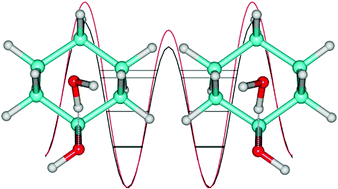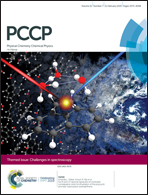Internal dynamics of cyclohexanol and the cyclohexanol–water adduct†
Abstract
Two conformers of cyclohexanol and the cyclohexanol–water adduct have been characterized in a jet expansion using rotational spectroscopy. In the gas phase, cyclohexanol adopts an equatorial position for the hydroxyl group, with the two conformers differing in the orientation of the hydroxylic hydrogen, either gauche or trans with respect to the aliphatic hydrogen at C(1). Axial cyclohexanol was not detected in the jet. The transitions of the gauche conformer are split into two component lines due to the tunneling effect of the O–H internal rotation, which connects two equivalent gauche minima. The tunneling splitting in the vibrational ground state has been determined to be ΔE0+0− = 52(2) GHz. From this splitting, the inversion barriers connecting the two equivalent gauche conformers have been determined using a flexible model to be B2 = 377 cm−1. A single isomer is detected for the cyclohexanol–water dimer, in which the water molecule acts as a proton donor to the equatorial gauche ring. The presence of torsional tunneling in the adduct suggests a concerted large-amplitude-motion in which the internal rotation in the ring is accompanied by a torsion of the water molecule, to produce an equivalent enantiomer. The torsional tunneling in the adduct is reduced to ΔE0+0− = 32.7(4) GHz and the potential barrier in the complex increases to B2 = 494 cm−1.

- This article is part of the themed collection: Challenges in spectroscopy: accuracy vs interpretation from isolated molecules to condensed phases


 Please wait while we load your content...
Please wait while we load your content...